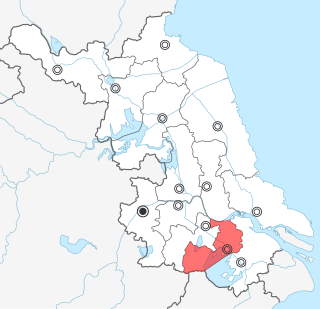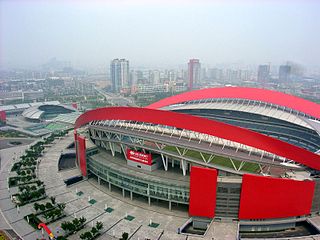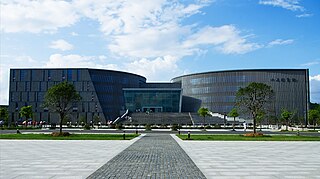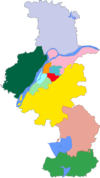
Nanjing, alternatively romanized as Nanking, is the capital of Jiangsu province of the People's Republic of China. It is a sub-provincial city, and a megacity. The city has 11 districts, an administrative area of 6,600 km2 (2,500 sq mi), and a population of 9,423,400 as of 2021. Situated in the Yangtze River Delta region, Nanjing has a prominent place in Chinese history and culture, having served as the capital of various Chinese dynasties, kingdoms and republican governments dating from the 3rd century to 1949, and has thus long been a major center of culture, education, research, politics, economy, transport networks and tourism, being the home to one of the world's largest inland ports. The city is also one of the fifteen sub-provincial cities in the People's Republic of China's administrative structure, enjoying jurisdictional and economic autonomy only slightly less than that of a province. Nanjing has been ranked seventh in the evaluation of "Cities with Strongest Comprehensive Strength" issued by the National Statistics Bureau, and second in the evaluation of cities with most sustainable development potential in the Yangtze River Delta. It has also been awarded the title of 2008 Habitat Scroll of Honor of China, Special UN Habitat Scroll of Honor Award and National Civilized City. Nanjing is also considered a Beta city classification, together with Chongqing, Hangzhou and Tianjin by the Globalization and World Cities Research Network, and ranked as one of the world's top 100 cities in the Global Financial Centres Index.

Hangzhou, also romanized as Hangchow, is the capital and most populous city of Zhejiang, China. It is located in the northwestern part of the province, sitting at the head of Hangzhou Bay, which separates Shanghai and Ningbo. Hangzhou grew to prominence as the southern terminus of the Grand Canal and has been one of China's most renowned and prosperous cities for much of the last millennium. It is a major economic and e-commerce hub within China, and the second biggest city in Yangtze Delta after Shanghai. Hangzhou is classified as a sub-provincial city and forms the core of the Hangzhou metropolitan area, the fourth-largest in China after Guangzhou-Shenzhen Pearl River agglomeration, Shanghai-Suzhou-Wuxi-Changzhou conurbation and Beijing. As of 2019, the Hangzhou metropolitan area was estimated to produce a gross metropolitan product (nominal) of 3.2 trillion yuan, making it larger than the economy of Nigeria. As of the 2020 Chinese census, it had a total population of 11,936,010 inhabitants. However, its metropolitan area, populated by 13.035 million people over an area of 8,107.9 km2 (3,130.5 sq mi), consists of all urban districts in Hangzhou and 3 urban districts of the city of Shaoxing.

Jiangsu is an eastern coastal province of the People's Republic of China. It is one of the leading provinces in finance, education, technology, and tourism, with its capital in Nanjing. Jiangsu is the third smallest, but the fifth most populous and the most densely populated of the 23 provinces of the People's Republic of China. Jiangsu has the highest GDP per capita and second-highest GDP of Chinese provinces, after Guangdong. Jiangsu borders Shandong in the north, Anhui to the west, and Zhejiang and Shanghai to the south. Jiangsu has a coastline of over 1,000 kilometers (620 mi) along the Yellow Sea, and the Yangtze River passes through the southern part of the province.

Suzhou, alternately romanized as Soochow, is a major city in southern Jiangsu province, East China. Suzhou is the most populous city in Jiangsu, and a major economic center and focal point of trade and commerce.

Wuxi is a city in southern Jiangsu province, eastern China, 135 kilometers (84 mi) by car to the northwest of downtown Shanghai, between Changzhou and Suzhou, and one of the central cities in the Yangtze River Delta. It is the ancient founding capital of the state of Wu and the origin of Jiangnan. As of the 2020 census, the city had a total population of 7,462,135 inhabitants.

Jing'an District is one of the central districts of Shanghai. In 2014, it had 1,180,000 inhabitants in an area of 37 km2 (14 sq mi).

Dongguan is a prefecture-level city in central Guangdong Province, China. An important industrial city in the Pearl River Delta, Dongguan borders the provincial capital of Guangzhou to the north, Huizhou to the northeast, Shenzhen to the south, and the Pearl River to the west. It is part of the Pearl River Delta built-up area with more than 65.57 million inhabitants as of the 2020 census spread over nine municipalities across an area of 19,870 square kilometres (7,670 sq mi).

The Dongcheng District of Beijing covers the eastern half of Beijing's urban core, including all of the eastern half of the Old City inside of the 2nd Ring Road with the northernmost extent crossing into the area within the 3rd Ring Road. Its 40.6 km2 (15.7 sq mi) area is further subdivided into 17 subdistricts.

Songjiang is a suburban district of Shanghai. It has a land area of 605.64 km2 (233.84 sq mi) and a population of 1,582,398 (2010). Owing to a long history, Songjiang is known as the cultural root of Shanghai.

The Stone City is the site of an ancient fortified city within Nanjing, Jiangsu province, China. Almost all of the original city is gone; all that remains are portions of the massive city wall.

Kowloon Park is a large public park in Tsim Sha Tsui, Kowloon, Hong Kong. It has an area of 13.3 hectares and is managed by the Leisure and Cultural Services Department.

Nanjing Automobile is a state-owned enterprise with a history that dates from 1947, making it the oldest of the Chinese automobile manufacturers although the comparatively younger FAW Automotive was the first to make cars.
The city of Beijing has a long and rich history that dates back over 3,000 years. Prior to the unification of China by the First Emperor in 221 BC, Beijing had been for centuries the capital of the ancient states of Ji and Yan. It was a provincial center in the earliest unified empires of China, Qin and Han. The northern border of ancient China ran close to the present city of Beijing, and northern nomadic tribes frequently broke in from across the border. Thus, the area that was to become Beijing emerged as an important strategic and a local political centre. During the first millennia of imperial rule, Beijing was a provincial city in northern China. Its stature grew in the 10th to the 13th centuries when the nomadic Khitan and forest-dwelling Jurchen peoples from beyond the Great Wall expanded southward and made the city a capital of their dynasties, the Liao and Jin. When Kublai Khan made Dadu the capital of the Mongol-led Yuan dynasty (1279–1368), all of China was ruled from Beijing for the first time. From 1279 onward, with the exception of two interludes from 1368 to 1420 and 1928 to 1949, Beijing would remain as China's capital, serving as the seat of power for the Ming dynasty (1421–1644), the Manchu-led Qing dynasty (1644–1912), the early Republic of China (1912–1928) and now the People's Republic of China (1949–present).

Beijing, alternatively romanized as Peking, is the capital of the People's Republic of China. With over 21 million residents, Beijing is the world's most populous national capital city as well as China's second largest city after Shanghai. It is located in Northern China, and is governed as a municipality under the direct administration of the State Council with 16 urban, suburban, and rural districts. Beijing is mostly surrounded by Hebei Province with the exception of neighboring Tianjin to the southeast; together, the three divisions form the Jingjinji megalopolis and the national capital region of China.

Seoul, officially known as the Seoul Special City, is the capital and largest metropolis of the Republic of Korea. According to the 2020 census, Seoul has a population of 9.9 million people, and forms the heart of the Seoul Capital Area with the surrounding Incheon metropolis and Gyeonggi province. Considered to be a global city and rated as an Alpha – City by Globalization and World Cities Research Network (GaWC), Seoul was the world's fourth largest metropolitan economy in 2014, following Tokyo, New York City and Los Angeles.

Jianye District is one of 11 districts of Nanjing, the capital of Jiangsu province, China.

Xuanwu Lake is located in Xuanwu District in the central-northeast part of Nanjing, Jiangsu. It is near the Nanjing Railway Station and Jiming Temple. Five islands within the lake are interconnected by arched bridges. Within the park are temples, pagodas, pavilions, gardens, teahouses, restaurants, entertainment venues, a small zoo, and other attractions. Its main entrance is the Xuanwu Gate.

Nanjing University is a national public research university in Nanjing, Jiangsu, China. It is a member of the prestigious C9 League and the Double First Class University. NJU has two main campuses: the Xianlin campus in the northeast of Nanjing, and the Gulou campus in the city center of Nanjing.

Jiangxin Island, or Jingxinzhou, is a spear-shaped island in the middle of the Yangtze, east of the Jianye District in Nanjing, China, 6.5 kilometres (4.0 mi) from the city's downtown district.

Xianlin University City, colloquially known as Xianlin, is a community in Nanjing, China, featuring a bunch of leading higher education institutions. It is located in the middle of Qixia District and to the northeast of Purple Mountain, 15 kilometers from Xinjiekou, the central business area of the city. Planned in 1995 and established in 2002, Xianlin is the earliest university city in China, followed by other famous higher education hubs like Songjiang University City and Guangzhou University City. Xianlin is the home to 12 higher education institutions, such as Nanjing University, Nanjing Normal University, and Nanjing University of Posts and Telecommunications, enabling them to share academic resources conveniently.




















